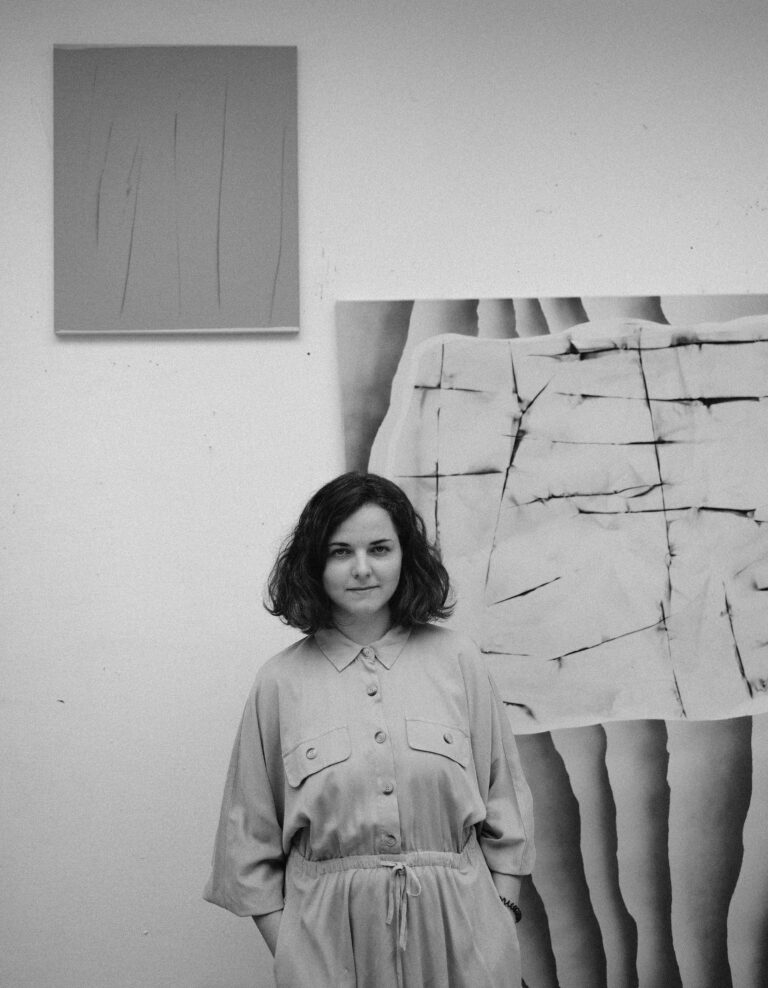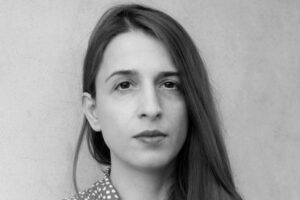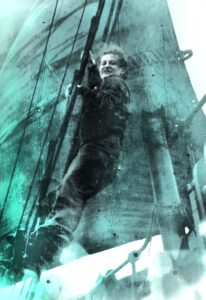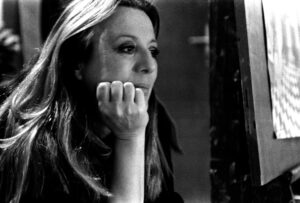Rita Koszorús

– born in 1989 in Bratislava. She began her art studies at the Josef Vydra School of Applied Arts in Bratislava. Subsequently, from 2008 to 2014, she studied at the Academy of Fine Arts in Bratislava, first at the Department of Free Graphics, later at the Department of Painting in the studio under the guidance of prof. Daniel Fischer. In 2013, she completed an internship at the Academy of Fine Arts in Budapest in a studio led by Imre Bukt. She has participated in several foreign residences and symposiums. She actively presents herself at individual and group exhibitions at home and abroad. She was a finalist in the Painting of the Year Award for three times.
Portrait photo of the artist by Marcus Oliver Obert.
My primary interests include the subject of identity. On one level, it reflects a natural search for my own place as I was born and live in Slovakia, but I have Hungarian nationality. However, I do not deal with a direct examination of the political problem, the question of nationality, but rather focus on the reflection of inner experience in the space between. It is equally important for me to find the identity of the painting itself. I deliberately build on its historical development and, through subtly shifts I examine the role of the painter today. I perceive art as a tool of improving or education, an opportunity to form an opinion – the basis for me, however, is a visual grip, in which it is only subsequently possible to decipher the references or attitudes. I find space for free play in this traditional medium, where the only limitation is the format.
My paintings are abstract compositions in which I connect various characters and structures. I like to experiment with the material, and I approach the canvas as a textile, a fabric that can be shaped. The smooth surface is replaced by tactile defiance, organic softness or airiness is complemented by rough, sometimes almost industrial materiality. I try to complicate the viewer’s view and the natural human instinct of categorization. When the incoherent elements in my works are combined, there is a certain disturbance, mutual overgrowth, or seepage, as if stone, concrete, gravel, wood, cardboard, or charcoal shines through the abstracted clouds. However, within the framework of the apparent contradictions, I strive for an atmospherically harmonious whole in which a comprehensive statement is legible. Abstraction allows me to release the subconscious and leave the black and white categories either/or. These exempted formulations are, for me, capable of harmony and internal consistency even in their contradictions. The resulting works embody the possibility of ambiguity, which is often the most authentic quality of our existence, regardless of whether we deal with nationality, emotions, or artistic categories. I also apply this liberated playfulness in a series of collages, which develops my painting series schMERZbild123. Also, in my collage work4 I use the above-mentioned approach through colour, material contrasts or a relaxed linear gesture. Like many side projects, these collages provide some insight into the principles of my approach to the painting.
However, this subtler work with contrast, disruption and stratification of identities was preceded by work with more specific processing. My school series of paintings, in which I studied the question of identity in diptychs through the two banks of the Danube, was followed by the happening Monumentus567, which took place directly on the riverbank. With the help of the locals, I planted cacti by the Danube in my home village, and with this planting of exotic plants in an (for them) inhospitable environment, I reflected on the themes of home, immigration, migration, and adaptation. The projects Hater Painter89 and Curator Shooting1011, in which visitors or the curator of the exhibition shot at my paintings with an airgun, represented a more intense examination of the identity of the painting. The element of a certain danger, the destruction of the “untouchable”, the joy of violating the forbidden, but also the aspect of vulnerability outline what I call “the second puberty in painting.” I think that after this rebel phase my works did not resign to questioning but matured into a more sophisticated coding.
A common denominator in my works is also the study of time, especially attempts to stop it. For me, art is a tool to break free from its standard flow – by exploring and capturing processuality, but also by creating the possibility of immersing myself in a certain timelessness. The time-conditioned quality is also the feeling of nostalgia, with which I work continuously. I problematize the possibility of capturing a collective feeling, a shared, universal experience. At the same time, however, by turning to the past, it is possible to approach finding (in the current world of insufficient) certainty – the past as immutable, solid, understandable in the context of the unreadable complexity of the present. Although I am developing a program of constant self-questioning and questioning, it is the space of nostalgia that can be a certain anchor. Nostalgia allows us to cultivate the idea of an ideal place that has been and where the tentacles of the demands of our daily lives will not reach. In my artwork, nostalgia can also be a starting point / refuge from overpressure of self-questioning – if we ask who I am or where I belong, it is only natural to talk also about what once was.
Finally, an important resource for my work is the past, specifically avant-garde movements. My interest in stepping out of the stereotypical perception of painting is enriched by the approaches of authors from the history of art, whose legacy I do not consider closed and which I want to move further. I focus my perception on feelings, essences, at first glance less conspicuous details – minor disturbances in everyday flow. The absurd detail, the moment of wit, is precisely the stopping of time that is characteristic of my artistic practice. Naturally, this results in my inclination to the knowledge that the Dada movement has brought. For me, the avant-garde is not a dead, petrified chapter in the history of art, but a source from which to draw and whose questions can be further developed, answered. For example, in the aforementioned schMERZbild series, I create works that on the one hand can be perceived as satisfactorily old-fashioned, but at the same time I strive to make them juicy contemporary. An integral part of this practice for me is also the knowledge that I refer to the legacy of the avant-garde as a woman. It is abstract painting or geometric abstraction that is often understood as a rational, masculine domain, into which, however, I freely enter, disrupt the strict positions of abstraction with lyrical elements and bring my essentially personal – and therefore also feminine – perspective.
The text was written in collaboration with Michaela Kučová (2021).
1Image: Rita Koszorús, Schmerzbild & yellow, 2019, 50 x 50 cm. Courtesy of the artist.2Image: Rita Koszorús, Liberté, 2020, 170 x 155 cm. Courtesy of the artist.
3Image: Rita Koszorús, schMERZbild and cloud, 2020, acrylic, ink on canvas, 80 x 80 cm. Courtesy of the artist.
4Image: Rita Koszorús, CUT cloud, 60 x 50 cm. Courtesy of the artist.
5Image: Rita Koszorús, Monumentus, happening on the bank of the Little Danube River in Vlky, see: http://ritakoszorus.com/monumentus/. Courtesy of the artist.
6Image: Rita Koszorús, Monumentus, happening on the bank of the Little Danube River in Vlky, see: http://ritakoszorus.com/monumentus/. Courtesy of the artist.
7Image: Rita Koszorús, Monumentus, happening on the bank of the Little Danube River in Vlky, see: http://ritakoszorus.com/monumentus/.Courtesy of the artist.
8Image: Rita Koszorús, Hater Painter, happening, foto Erik Adamson. Courtesy of the artist.
9Image: Rita Koszorús, Hater Painter, painting. Courtesy of the artist.
10Image: Rita Koszorús, Curator shooting, curator's participation in the creation of the painting. Courtesy of the artist.
11Image: Rita Koszorús, David's first shot, 2015, acrylic, spray, shot canvas, 120 x 100 cm. Courtesy of the artist.

– sa narodila v roku 1989 v Bratislave. Svoje výtvarné štúdia začala na Škole úžitkového výtvarníctva Josefa Vydru v Bratislave. Následne v rokoch 2008 až 2014 študovala na Vysokej škole výtvarných umení v Bratislave, najskôr na oddelení voľnej grafiky, neskôr na katedre maľby v ateliéri pod vedením prof. Daniela Fischera. V roku 2013 absolvovala stáž na Akadémii krásnych umení v Budapešti v ateliéri pod vedením Imreho Buktu. Zúčastnila sa niekoľkých zahraničných rezidencii a sympózií. Aktívne sa prezentuje na samostatných a skupinových výstavách doma a v zahraničí. Bola trikrát finalistkou súťaže Maľba roka.
Portrétna fotografia umelca od Marcusa Olivera Oberta.
Medzi moje primárne záujmy patrí téma identity. V jednej rovine ide o prirodzené hľadanie vlastného miesta – narodila som sa a žijem na Slovensku, no mám maďarskú národnosť. Nezaoberám sa však priamočiarym skúmaním politického problému, otázkou národnosti, skôr sa sústredím na reflexiu vnútorného prežívania v priestore medzi. Podobne dôležité je pre mňa hľadanie identity samotnej maľby. Zámerne nadväzujem na jej historický vývin a viac či menej subtílnymi posunmi skúmam rolu maliara/maliarky v dnešnej spoločnosti. Umenie vnímam ako nástroj cibrenia či vzdelávania, príležitosť na formovanie názoru – základom pre mňa však je vizuálne opantanie, v ktorom je až následne možné dešifrovať odkazy či postoje. V tradičnom médiu nachádzam priestor pre slobodnú hru, v ktorej jediným limitom je formát.
Moje maľby predstavujú abstraktné kompozície, v ktorých prepájam rozličné charaktery a štruktúry. S materiálom rada experimentujem a k maliarskemu plátnu sprvu pristupujem ako k textilu, látke, ktorú možno tvarovať. Hladký povrch strieda priam hmatateľný vzdor, organickú mäkkosť až vzdušnosť dopĺňa drsná, miestami takmer industriálna materialita. Snažím sa komplikovať nazeranie diváka a prirodzený ľudský inštinkt kategorizovania. Pri spojení nesúrodých prvkov v mojich dielach dochádza k určitému narúšaniu, vzájomnému prerastaniu či presakovaniu, v abstrahovanej oblačnosti akoby presvitá kameň, betón, štrk, drevo, kartón či uhoľ. V rámci zdanlivej protichodnosti sa však usilujem o atmosféricky harmonický celok, v ktorom je čitateľná ucelená výpoveď. Abstrakcia mi umožňuje uvoľnenie podvedomia a opustenie čierno-bielych kategórií buď/alebo. Takto oslobodené formulácie sú pre mňa aj vo svojich rozporoch schopné súladu a vnútornej konzistentnosti. Výsledné diela zosobňujú možnosť nejednoznačnosti, ktorá je často najautentickejšou kvalitou našej existencie, bez ohľadu na to, či sa zaoberáme národnosťou, emóciami či umeleckými kategóriami. Túto oslobodenú hravosť uplatňujem aj v sérii koláží, ktorá rozvíja moju maliarsku sériu schMERZbild123. Aj v kolážovej tvorbe4 využívam vyššie spomínaný prístup prostredníctvom farebných i materiálových kontrastov či uvoľneného lineárneho gesta. Podobne ako mnohé side projecty, tieto koláže poskytujú istý vhľad do spomínaných princípov toho, ako pristupujem k maliarskej časti svojej tvorby.
Tejto subtílnejšej práci s kontrastom, narúšaním a vrstevnatosťou identít však predchádzali práce s konkrétnejším spracovaním. Na moju školskú sériu malieb, kde som v diptychoch skúmala otázku identity prostredníctvom dvoch brehov Dunaja, nadviazal happening Monumentus567 odohrávajúci sa priamo na brehu rieky. S pomocou miestnych som pri Dunaji vo svojej rodnej obci vysadila kaktusy a týmto zasadením exotických rastlín do (pre ne) nehostinného prostredia reflektovala témy domova, prisťahovalectva, migrácie a adaptácie. Vyhrotenejšie skúmanie identity maľby zas predstavovali projekty Hater Painter89 a Curator Shooting1011, počas ktorých do mojich obrazov vzduchovkou strieľali návštevníci či kurátor/kurátorka výstavy. Element istého nebezpečia, deštrukcie „nedotknuteľného“, radosti z porušenia zakázaného, ale i aspekt zraniteľnosti načrtávajú to, čo označujem ako „druhú pubertu v maľbe“. Myslím si, že moje diela po tejto fáze istého buričstva nerezignovali na spochybňovanie, ale dozreli do sofistikovanejšieho kódovania.
Spoločným menovateľom v mojich dielach je aj skúmanie času, najmä pokusy o jeho zastavenie. Umenie je pre mňa nástrojom na vytrhnutie z jeho štandardného plynutia – prostredníctvom skúmania a zachytávania procesuálnosti, ale aj vytvorením možnosti ponorenia sa do určitého bezčasia. Časovo podmienenou kvalitou je aj pocit nostalgie, s ktorým kontinuálne pracujem. Problematizujem možnosť zachytenia kolektívneho pocitu, zdieľaného, univerzálneho zážitku. Zároveň však práve obrátením sa do minulosti sa podľa mňa možno priblížiť aj k nachádzaniu (v súčasnom svete nedostatkovej) istoty – minulé ako nemenné, pevné, zrozumiteľné v kontexte nečitateľnej komplexnosti súčasnosti. Hoci rozvíjam program sebaspytovania a spochybňovania, práve priestor nostalgie môže byť istým ukotvením. Nostalgia nám umožňuje pestovať predstavu ideálneho miesta, ktoré bolo a kam nedosiahnu chápadlá požiadaviek nášho každodenného života. V prípade mojej umeleckej práce tak nostalgia môže tiež byť východiskom/útočiskom pred pretlakom sebaspytovania – ak sa pýtame, kto som ja, kam patrím, prirodzene sa ponúka hovoriť o tom, čo bolo.
Nakoniec, významným zdrojom je pre mňa pri tvorbe práve minulosť, konkrétne avantgardné hnutia. Môj záujem o vykročenie zo stereotypného vnímania maľby obohacujú prístupy autoriek a autorov z histórie umenia, ktorých odkaz nepovažujem za uzavretý a ktorý chcem ďalej posúvať. Svoje vnímanie sústreďujem na pocity, esencie, na prvý pohľad menej nápadné detaily – drobné vyrušenia v každodennom plynutí. Absurdný detail, okamih vtipu, je práve tým zastavením času, ktoré je charakteristické pre moju umeleckú prax. Prirodzene z toho vyplýva moja inklinácia k poznaniu, ktoré v tomto smere prinieslo napríklad hnutie dada. Avantgarda pre mňa nie je mŕtva, skamenelá kapitola dejín umenia, ale zdroj, z ktorého možno čerpať a ktorého otázky možno ďalej rozvíjať, dopovedávať. Napríklad v spomínanej sérii schMERZbild z tohto východiska vytváram diela, ktoré možno na jednej strane vnímať ako uspokojivo starosvetské, no zároveň usilujem o to, aby boli šťavnato súčasné. Neoddeliteľnou súčasťou tejto praxe je pre mňa zároveň vedomie, že sa k odkazu avantgárd vzťahujem ako žena. Práve abstraktná maľba, respektíve geometrická abstrakcia je často chápaná ako racionálna, mužská doména, do ktorej však dnes slobodne vstupujem, narúšam striktné polohy abstrakcie lyrickými prvkami a prinášam svoju bytostne osobnú – a teda aj ženskú – perspektívu.
Text bol vytvorený v spolupráci s Michaelou Kučovou (2021).
1Obrázok: Rita Koszorús, Schmerzbild & yellow, 2019, 50 x 50 cm. S láskavým dovolením umelkyne.2Obrázok: Rita Koszorús, Liberté, 2020, 170 x 155 cm. S láskavým dovolením umelkyne.
3Obrázok: Rita Koszorús, schMERZbild and cloud, 2020, akryl, atrament na plátne, 80 x 80 cm. S láskavým dovolením umelkyne.
4Obrázok: Rita Koszorús, CUT cloud, 60 x 50 cm. S láskavým dovolením umelkyne.
5Obrázok: Rita Koszorús, Monumentus, happening na brehu Malého Dunaja vo Vlkoch, viď: http://ritakoszorus.com/monumentus/. S láskavým dovolením umelkyne.
6Obrázok: Rita Koszorús, Monumentus, happening na brehu Malého Dunaja vo Vlkoch, viď: http://ritakoszorus.com/monumentus/. S láskavým dovolením umelkyne.
7Obrázok: Rita Koszorús, Monumentus, happening na brehu Malého Dunaja vo Vlkoch, viď: http://ritakoszorus.com/monumentus/. S láskavým dovolením umelkyne.
8Obrázok : Rita Koszorús, Hater Painter , happening, foto Erik Adamson. S láskavým dovolením umelkyne.
9Obrázok: Rita Koszorús, Hater Painter, painting. S láskavým dovolením umelkyne.
10Obrázok: Rita Koszorús, Curator shooting, participácia kurátora na tvorbe maľby. S láskavým dovolením umelkyne.
11Obrázok: Rita Koszorús, Dávidova prvá rana, 2015, akryl, spray, prestrelene plátno, 120 x 100 cm. S láskavým dovolením umelkyne.



